The religious composition of the 119th Congress
Every two years, Pew Research Center publishes a report on the religious affiliation of members of the incoming Congress. This report is the ninth in the series, which started with the 111th Congress that began in 2009.
Data on members of Congress comes from CQ Roll Call, which surveys members about their demographic characteristics, including religious affiliation. Pew Research Center researchers then code the data so that Congress can be compared with U.S. adults overall. For example, members of Congress who tell CQ Roll Call they are “Southern Baptists” are coded as “Baptists” – a broader category (including Southern Baptists as well as other Baptists) used for analysis of the general public.
Data in this report covers voting members of Congress scheduled to be sworn in on Jan. 3, 2025. While there are 535 voting seats in Congress (100 in the Senate and 435 in the House of Representatives), this analysis excludes three of those seats: Florida’s 1st District seat, due to the resignation of Matt Gaetz; Florida’s 6th District seat, due to the announced resignation of Michael Waltz; and the Ohio Senate seat held by JD Vance, who is set to become vice president on Jan. 20, 2025. This analysis, then, looks at 532 members of Congress rather than 535.
Data for all U.S. adults comes from Pew Research Center’s 2023 National Public Opinion Reference Survey (NPORS), conducted May 19-Sept. 5, 2023. Figures for Protestant subgroups, Messianic Jews, Unitarians and Humanists come from the Center’s American Trends Panel (ATP) survey conducted Aug. 7-27, 2023. Jewish estimates come from the Center’s survey of Jewish Americans, conducted Nov. 19, 2019-June 3, 2020. Read more about how Pew Research Center measures the religious composition of the United States.
When the U.S. Congress convenes for its 119th session on Jan. 3, it will have marginally fewer Christians than it did in the previous session (2023-25), continuing a gradual, 10-year decline. Christians will make up 87% of voting members in the Senate and House of Representatives, combined, in the 2025-27 congressional session. That’s down from 88% in the last session and 92% a decade ago.
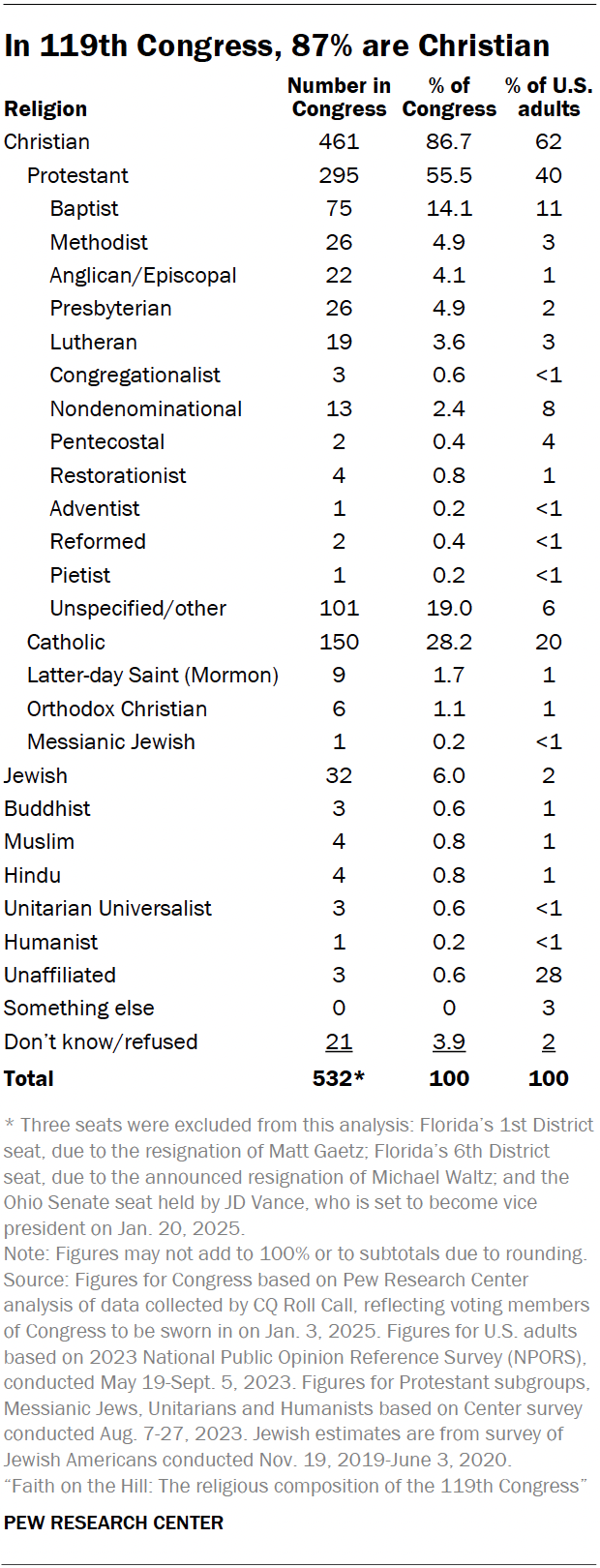
Overall, there will be 461 Christian members of Congress when the 119th Congress meets, compared with 469 in the previous Congress and 491 during the 2015-17 session. It will be the lowest number of Christians since the start of the 2009-2011 congressional session, the first for which Pew Research Center conducted this analysis.
(This analysis does not include three vacant – or soon to be vacant – seats whose eventual occupants are unknown, including the Ohio Senate seat of Vice President-elect JD Vance.)
And yet, at 87%, Christians still make up the lion’s share of the Congress, far exceeding the Christian share of all U.S. adults, which stands at 62% after several decades of decline. In 2007, 78% of American adults were Christian, according to Pew Research Center’s Religious Landscape Study from that year, and in the early 1960s more than nine-in-ten U.S. adults were Christian, according to historical Gallup polling.
The new Congress is also more religious than the general population by another, related measure: Nearly three-in-ten Americans (28%) are religiously unaffiliated, meaning they are atheist or agnostic or say their religion is “nothing in particular.” But less than 1% of Congress falls into this category, with three religiously unaffiliated members: incoming Reps. Yassamin Ansari of Arizona and Emily Randall of Washington, both of whom are Democrats, and incoming Rep. Abraham Hamadeh of Arizona, a Republican.
While the share of the U.S. public that is religiously unaffiliated – sometimes called “nones” – has risen rapidly in recent decades (from 16% in 2007 to 28% in our recent polling), the corresponding share of Congress has remained miniscule. Prior to the 119th session, the only member of Congress who was categorized as religiously unaffiliated in our analyses was Kyrsten Sinema, independent of Arizona, who served from 2013 through the Congress that is just ending. (She did not run for reelection in 2024.)
Pew Research Center’s analysis is based on data from CQ Roll Call, a publisher in Washington, D.C., that has closely covered Congress for decades.
Breakdown by denomination
Of the 461 Christians in the 119th Congress, 295 are Protestant, a decrease of eight from the previous session. Partial historical data suggests that Protestants had a much larger presence in Congress a few decades ago, including 398 members in 1961. But there have been fewer than 300 Protestants in six of the last nine sessions over the last decade and a half.
That said, Protestants continue to make up a disproportionately high share of the 119th Congress (55% of members) when compared with the U.S. adult population (40%).
Baptists are the largest category of Protestants in the new Congress, with 75 members (14.1% of Congress). That’s eight more Baptists than in the prior session.
The next largest Protestant groups in the new Congress are Methodists (26 members), Presbyterians (26), Episcopalians (22) and Lutherans (19). These four groups have had shrinking U.S. memberships in recent decades and now have a considerably smaller presence in Congress than they used to. For example, in the 112th Congress of 2011-13, there were 51 Methodists, 45 Presbyterians, 41 Episcopalians and 26 Lutherans.
Of the 295 Protestants in Congress, 101 do not specify a particular denomination or denominational family, instead giving broad or vague answers such as “Protestant,” “Christian” or “evangelical Protestant.” This is six fewer who identify in those ways than in the last Congress, but the overall trend during the last decade has been for increasing numbers of U.S. representatives and senators to give these kinds of answers. By comparison, only 58 members said they were “just Christians” or gave nonspecific, Protestant descriptions of their religious affiliation at the start of the 114th Congress in 2015.
The new Congress also has 150 Catholics, two more than in the last session. Still, that’s lower than the average number of Catholic members over the last decade and a half. More often than not, since the 2009-2011 session, congressional Catholics have numbered in the 160s.
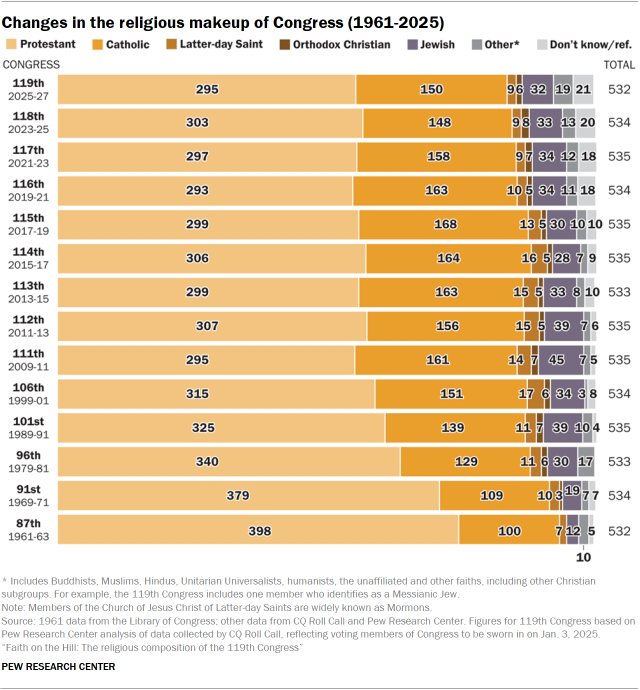
Additionally, the new Congress will have nine members of the Church of Jesus Christ of Latter-day Saints (widely known as Mormons). That is the same number as in the last two Congresses.
Seventy-one members of Congress do not identify as Christians, including 32 who are Jewish. Although that is one fewer Jewish member of Congress than in the last session, Jews continue to make up a higher share of Congress (6%) than of the overall adult population (2%).
There will be four Muslims in the new House of Representatives – one more than in the last session – including three who won reelection in 2024 (André Carson, D-Ind., Ilhan Omar, D-Minn., and Rashida Tlaib, D-Mich.). The newest Muslim to enter the House will be Lateefah Simon, D-Calif.
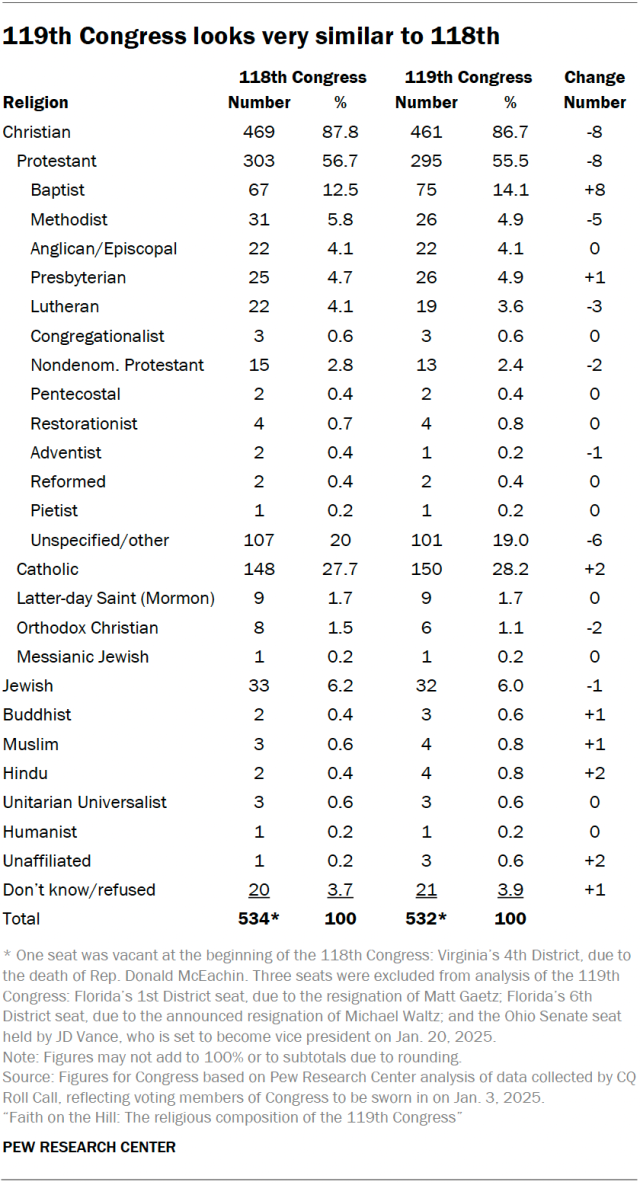
There also will be four Hindus in the House – two more than in the previous session. Three won reelection in 2024 – Ro Khanna, D-Calif.; Raja Krishnamoorthi, D-Ill.; and Shri Thanedar, D-Mich. – and one, Suhas Subramanyam, D-Va., will be a freshman.
Three Buddhists are set to serve in the new Congress, an increase of one. They include incumbents Rep. Hank Johnson, D-Ga., and Sen. Mazie Hirono, D-Hawaii, and freshman Rep. Derek Tran, D-Calif.
In addition, there are three members who identify as Unitarian Universalists. All three are returning for another term: Reps. Deborah Ross, D-N.C., Ami Bera, D-Calif., and Judy Chu, D-Calif.
Twenty-one members of the new Congress are categorized as having unknown religious affiliation, meaning they declined to identify their religion; chose to identify as “unspecified”; or were unable to be reached.
These are among the key findings of a Pew Research Center analysis of data from CQ Roll Call, which sends questionnaires to every new member of Congress and follows up as needed. The CQ questionnaire asked members of the incoming 119th Congress to identify their religion. It did not ask about their religious beliefs or practices. Pew Research Center categorized the data and compared the religious affiliations of members of Congress with the Center’s national surveys of the U.S. public.
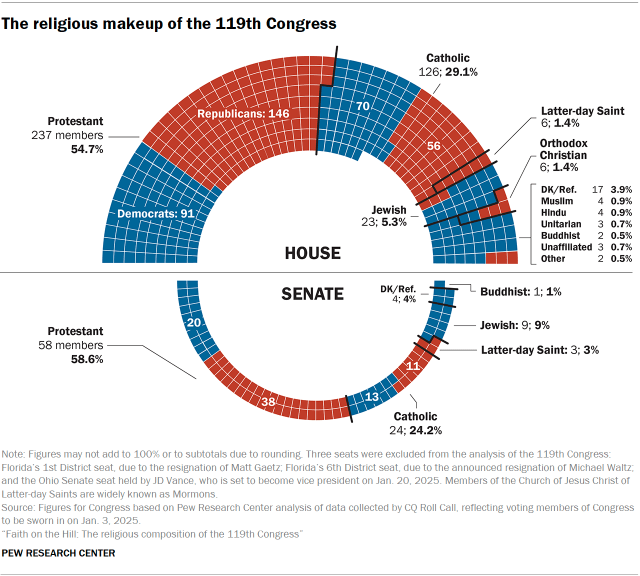
Differences by chamber
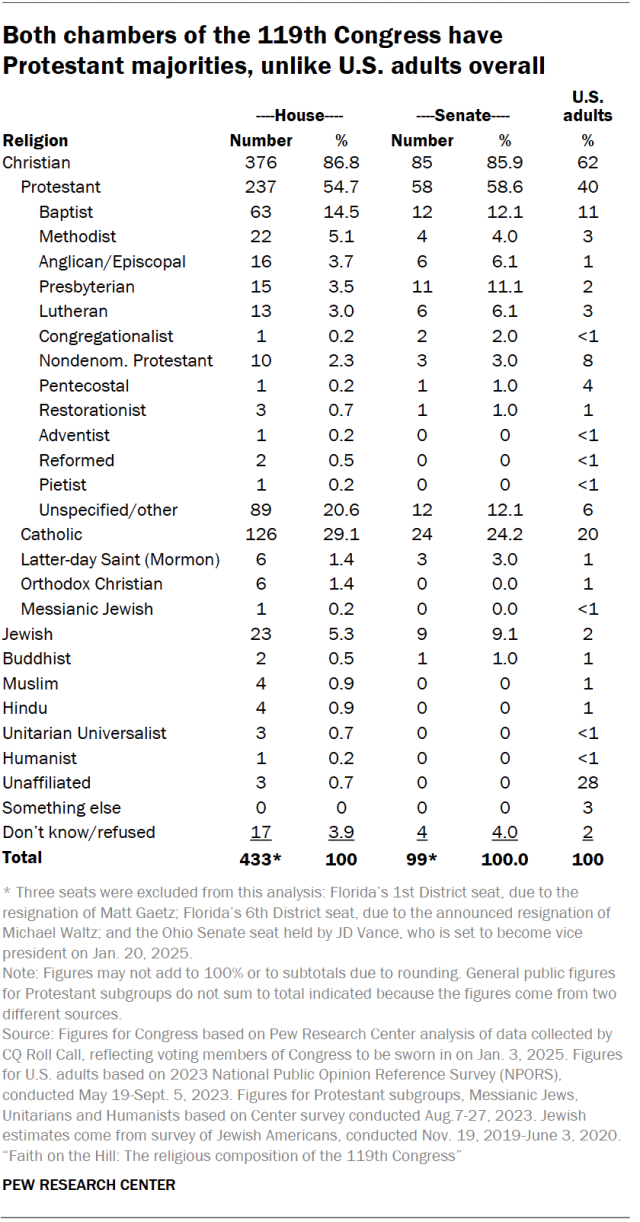
In the incoming 119th Congress, Protestants make up majorities of both the Senate (59%) and the House (55% of voting members).
Baptists, the largest Protestant subgroup, comprise a slightly higher share of the House than the Senate (15% vs. 12%).
Presbyterians, on the other hand, make up a higher share of the Senate than the House (11% vs. 3%). The same is true for Episcopalians, Lutherans and Congregationalists.
Catholics are set to have a wider presence in the House than in the Senate (29% vs. 24%) during the 119th Congress, while all six Orthodox Christians in Congress are in the House.
Looking at non-Christians in Congress, Jews make up a higher share of the Senate (9%) than the House (5%). All the Muslims, Hindus and Unitarian Universalists in Congress are in the House, as is the sole member of Congress who identifies as a humanist, Jared Huffman, D-Calif.
Of the 10 senators who identify with a non-Christian religion, nine are Jewish and one is Buddhist (Mazie Hirono of Hawaii, a Democrat).
Breakdown by party
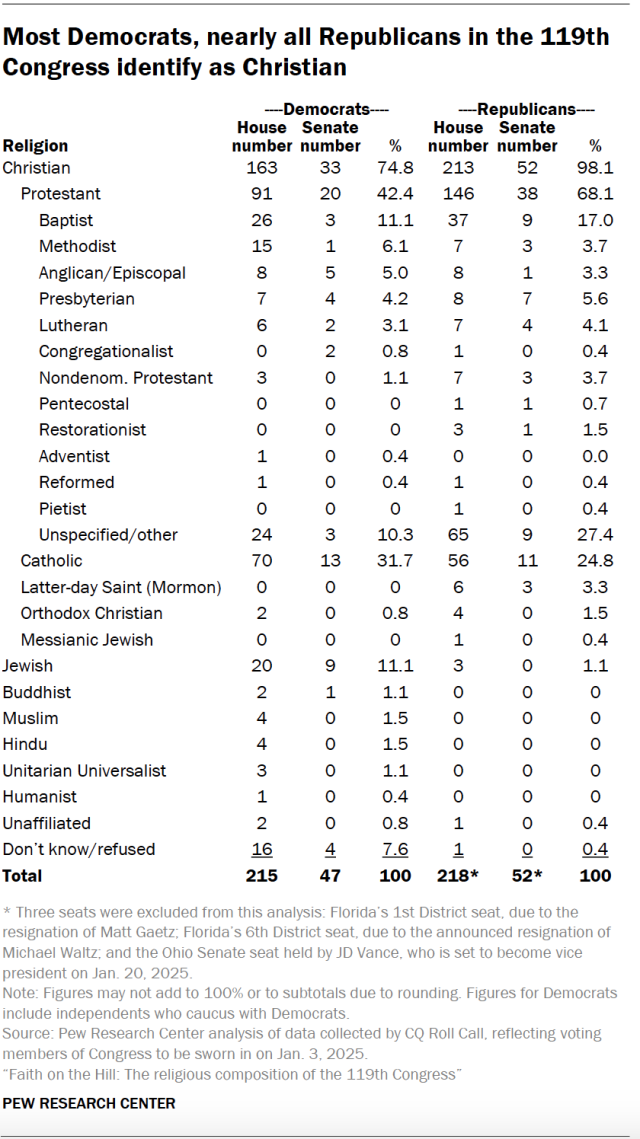
Nearly all Republicans in the 119th Congress (265 out of 270, or 98%) identify as Christian, compared with a smaller but still substantial majority of Democrats who are Christian (196 out of 262, or 75%). The congressional rosters of both parties are more heavily Christian than the U.S. population overall (62%).
Protestants make up a higher share of Republicans than Democrats in Congress (68% vs. 42%), while Catholics form a higher proportion of congressional Democrats than Republicans (32% vs. 25%).
All nine Latter-day Saints in Congress are Republicans. The one member of Congress who identifies as a Messianic Jew, Rep. Anna Paulina Luna of Florida, is also a Republican.
Of the five congressional Republicans who are not Christian, three are Jewish (Reps. Craig Goldman of Texas, David Kustoff of Tennessee and Max Miller of Ohio). One is categorized as religiously unaffiliated, and one is categorized as “Don’t know/refused.”
Of the 66 congressional Democrats who are not Christian, 29 are Jewish, four are Muslim, four are Hindu, three are Unitarian Universalists, three are Buddhist, two are religiously unaffiliated (Reps. Yassamin Ansari of Arizona and Emily Randall of Washington), one self-identifies as a humanist (Rep. Jared Huffman of California), and 20 did not specify a religion.
First-time members
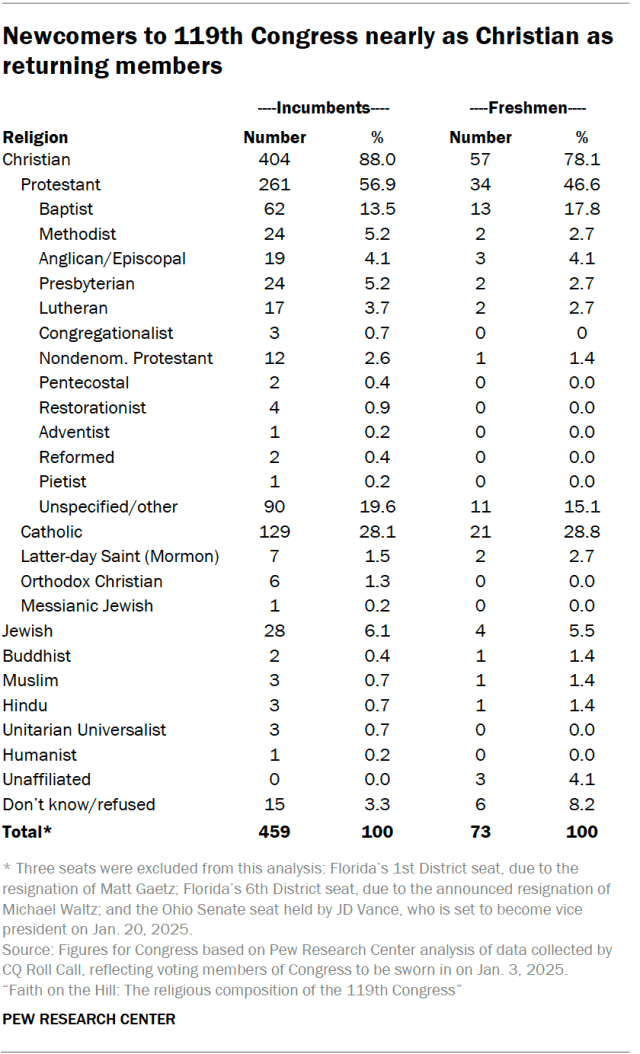
There are 73 newcomers to the 119th Congress, and they make up about one-seventh of the entire body. These newcomers are less likely than the returning members of Congress to be Christian (78% vs. 88%).
First-term members of Congress are also less likely than returning members to be Protestant (47% vs. 57%). And among Protestants in Congress, 15% of newcomers describe themselves in broad or vague terms as “Christian,” “Protestant,” “evangelical Christian” or “evangelical Protestant,” compared with a slightly higher share of returning members (20%) who are in this “Unspecified/other” Protestant category.
First-term members of Congress and returning members are about equally likely to be Catholic (29% vs. 28%). They are also equally likely to call themselves Episcopalian (4%).
No first-termers are Orthodox Christians. All six Orthodox Christians in the 119th Congress are returning members.
Looking at non-Christians, Jews make up about equal shares of newcomers and returning members to Congress.
Other non-Christian first-term members of Congress include one Buddhist (Rep. Derek Tran, D-Calif.), one Muslim (Rep. Lateefah Simon, D-Calif.), one Hindu (Rep. Suhas Subramanyam, D-Va.), and three “nones” (Democratic Reps. Yassamin Ansari of Arizona and Emily Randall of Washington, and Republican Rep. Abraham Hamadeh of Arizona).




